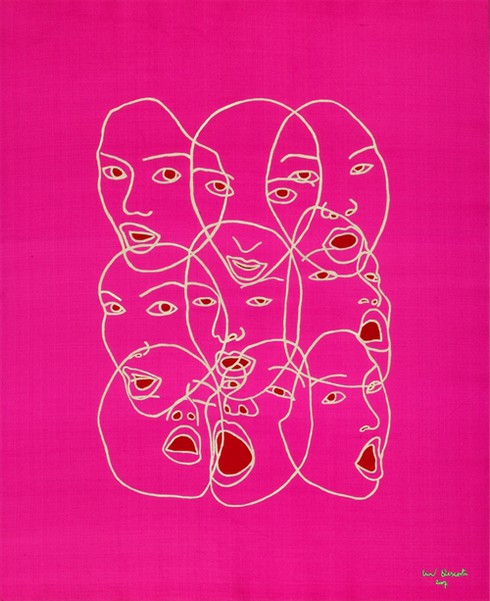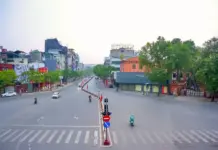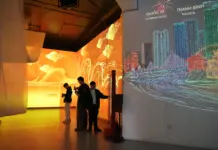Descostes was pleased that his atrowrk was very well received by the public in Bangkok.
“Most of them didn’t believe that it was all made by hand, even by embroidery. I’m glad of how they reacted because the process to make one piece takes time and it’s a hard job to do it. I’m also happy to tell them it has been made in Vietnam,” said the 50 year-old artist.
Five years ago, when his artworks were displayed in a solo exhibition From a Stroke to a Thread at the French cultural centre in Hanoi, they were also highly appreciated by the public. He could prove to the art lovers that traditional embroidery could find its place within contemporary art. The exhibition inspired a new appreciation for visitors on a popular but little understood art form.
Falling in love with the traditional art of embroidery of Vietnam, the artist has been the first to take on the Vietnamese embroidery technique and reinvent it for their artistic practice, moving it out of the realm of traditional craft onto the stage of contemporary art.
After 20 years living in Asia and 16 years in Vietnam, he has become a lover of the country and found endless inspiration to create artworks from embroidery.
Before coming to the S-shaped country, he began his professional career by working in the field of craftwork, and then decided to go back to study Art history in France. Upon completion of his studies he developed several products in various sectors as a concept designed and went abroad for three years, conducting research about art in Japan, Singapore, and Indonesia.
In 2000, he first came to Hanoi as a factory director (at Lacquer Factory, belonging to Apple Tree Group). During that time, he discovered the city and loved its fast pace and the friendly relationships he developed with local people. Two years later, he stopped his job to concentrate on his art project in Vietnam.
Love of embroidery
Alerted by the decline of craftwork villages in modern Vietnam, Descostes decided to use art to keep embroidery alive and support the community.
“I felt sorry to see the art and craft villages around Hanoi slowly disappear because of mechanisation or competition… I just wanted to say ‘please don’t lose this savoir-faire made by many generations’.”
“When you see the beautiful Vietnamese imperial embroideries, you feel sad that embroideries are now mostly made as souvenirs for tourists and that their quality has diminished,” he said. “Contemporary art can be made on all kinds of mediums. Unfortunately, people have an idea that embroidery only belongs to decorative items,” he adds.
In 2002, Lionel Descostes started experimenting with various techniques in order to find the one which would best suit his art work. He took 6 months to create his own technique: “one thread handmade embroidery” and then decided to set himself apart in his Hanoi studio, exclusively focused on his work over 12 years and expressing his art and ideas with patience, assiduity and rigor. His inspirations come directly from his daily life in Vietnam, and his past experiences.
While doing this, he also showed a deep commitment to help disabled people fit into professional and social life by hiring 9 deaf and mute girls and training them on his technique.
“Working on my project, these girls discovered a new approach to embroidery,” he explains.
“The place of each individual in the community is very important in my work; by involving handicapped people in this project, I helped them to integrate themselves into society and to have their own life,” he said. “Firstly, I taught them my one thread technique, then we started to work together. Some years after, some of them got married, some went back to their hometown or left to live a more ordinary life. I also taught them some specific things which belonged to art, because they are very sensitive. I strongly believe that one day, they will be able to develop their own creations,” he said.
Some of his pieces are in different collections all around the world.
”I really hope developing a high quality of handicraft, including embroidery, in Vietnam will interest more people to work with it,” he said.
Six months ago he moved to Hoi An with his wife and they are now developing a concept of a bar restaurant named “Belleville” that involves art, such as live music or visual pieces…
“It’s a new exciting project which I’ll be working on with my art for the next few years”.




